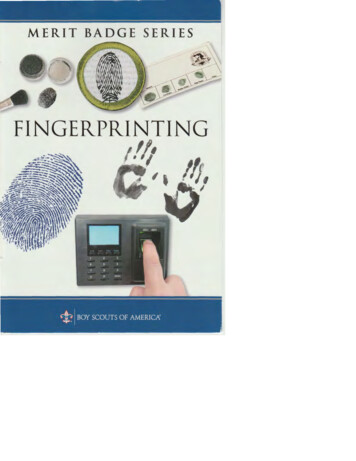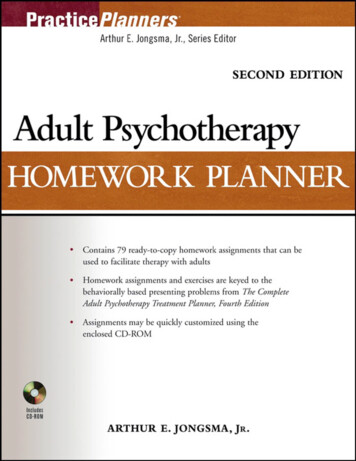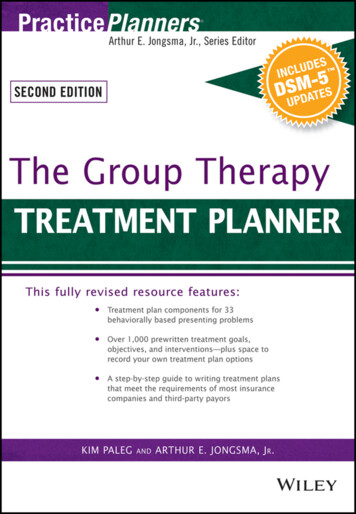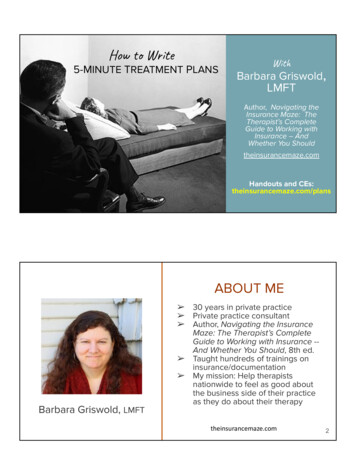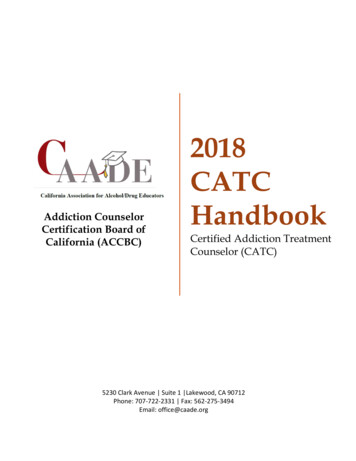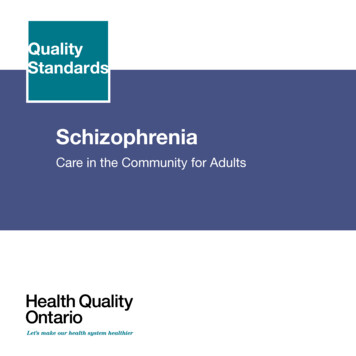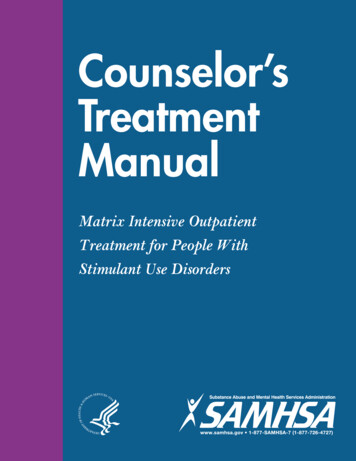
Transcription
Counselor’sTreatmentManualMatrix Intensive OutpatientTreatment for People WithStimulant Use Disorders
This page intentionally left blank
Counselor’s TreatmentManualMatrix Intensive Outpatient Treatment forPeople With Stimulant Use DisordersU.S. DEPARTMENT OF HEALTH AND HUMAN SERVICESSubstance Abuse and Mental Health Services AdministrationCenter for Substance Abuse Treatment1 Choke Cherry RoadRockville, MD 20857
AcknowledgmentsNumerous people contributed to this document, which is part of the Methamphetamine Treatment Project (MTP).The document was written by Jeanne L. Obert, M.F.T., M.S.M.; Richard A. Rawson, Ph.D.; Michael J. McCann,M.A.; and Walter Ling, M.D. The MTP Corporate Authors provided valuable guidance and support on this document.This publication was developed with support from the University of California at Los Angeles (UCLA) CoordinatingCenter through Grant No. TI11440. MTP was funded by the Center for Substance Abuse Treatment (CSAT),Substance Abuse and Mental Health Services Administration (SAMHSA), U.S. Department of Health and HumanServices (HHS). The research was conducted from 1998 to 2002 in cooperation with the following institutions:County of San Mateo, San Mateo, CA (TI11411); East Bay Recovery Project, Hayward, CA (TI11484); FriendsResearch Institute, Inc., Concord, CA (TI11425); Friends Research Institute, Inc., Costa Mesa, CA (TI11443); SaintFrancis Medical Center of Hawaii, Honolulu, HI (TI11441); San Diego Association of Governments, San Diego, CA(TI11410); South Central Montana Regional Mental Health Center, Billings, MT (TI11427); and UCLA CoordinatingCenter, Los Angeles, CA (TI11440). The publication was produced by JBS International, Inc. (JBS), underKnowledge Application Program (KAP) contract numbers 270-99-7072 and 270-04-7049 with SAMHSA, HHS.Christina Currier served as the CSAT Government Project Officer. Andrea Kopstein, Ph.D., M.P.H., served as theDeputy Government Project Officer. Cheryl Gallagher, M.A., served as CSAT content advisor.DisclaimerThe views, opinions, and content of this publication are those of the authors and do not necessarily reflect theviews, opinions, or policies of SAMHSA or HHS.Public Domain NoticeAll materials appearing in this publication except those taken from copyrighted sources are in the public domainand may be reproduced or copied without permission from SAMHSA or the authors. Citation of the source isappreciated. However, this publication may not be reproduced or distributed for a fee without the specific, writtenauthorization of the Office of Communications, SAMHSA, HHS.Electronic Access and Printed CopiesThis publication may be ordered or downloaded from SAMHSA’s Publications Ordering Web page athttp://store.samhsa.gov. Or, please call SAMHSA at 1-877-SAMHSA-7 (1-877-726-4727) (English and Español).Recommended CitationCenter for Substance Abuse Treatment. Counselor’s Treatment Manual: Matrix Intensive Outpatient Treatment forPeople With Stimulant Use Disorders. HHS Publication No. (SMA) 13-4152. Rockville, MD: Substance Abuse andMental Health Services Administration, 2006.Originating OfficeQuality Improvement and Workforce Development Branch, Division of Services Improvement, Center for SubstanceAbuse Treatment, Substance Abuse and Mental Health Services Administration, 1 Choke Cherry Road, Rockville,MD 20857.HHS Publication No. (SMA) 13-4152First Printed 2006Reprinted 2007, 2008, 2009, 2010, 2011, 2013, and 2014
ContentsI. Introduction to the Matrix Intensive Outpatient Treatment for PeopleWith Stimulant Use Disorders Approach and Package . . . . . . . . . . . . . . . . . . . 1Background . . . . . . . . . . . . . . . . . . . . . . . . . . . . . . . . . . . . . . . . . . . . . . . . . . . . . . . . . . . . . . . . 1Matrix IOP Approach . . . . . . . . . . . . . . . . . . . . . . . . . . . . . . . . . . . . . . . . . . . . . . . . . . . . . . . . . 2The Role of the Counselor . . . . . . . . . . . . . . . . . . . . . . . . . . . . . . . . . . . . . . . . . . . . . . . . . . . . 6Working With Client Co-Leaders and Client–Facilitators . . . . . . . . . . . . . . . . . . . . . . . . . . . . . 7The Matrix IOP Package . . . . . . . . . . . . . . . . . . . . . . . . . . . . . . . . . . . . . . . . . . . . . . . . . . . . . . 8Introduction to the Counselor’s Treatment Manual . . . . . . . . . . . . . . . . . . . . . . . . . . . . . . . . . . 9II. The Role of Drug and Breath-Alcohol Testing in Matrix IOP . . . . . . . . . . . . . . 11Philosophy . . . . . . . . . . . . . . . . . . . . . . . . . . . . . . . . . . . . . . . . . . . . . . . . . . . . . . . . . . . . . . . . 11Procedure . . . . . . . . . . . . . . . . . . . . . . . . . . . . . . . . . . . . . . . . . . . . . . . . . . . . . . . . . . . . . . . . 11Addressing a Positive Urine Test . . . . . . . . . . . . . . . . . . . . . . . . . . . . . . . . . . . . . . . . . . . . . . 12III. Individual/Conjoint Sessions . . . . . . . . . . . . . . . . . . . . . . . . . . . . . . . . . . . 15Introduction . . . . . . . . . . . . . . . . . . . . . . . . . . . . . . . . . . . . . . . . . . . . . . . . . . . . . . . . . . . . . . . 15Session 1: Orientation . . . . . . . . . . . . . . . . . . . . . . . . . . . . . . . . . . . . . . . . . . . . . . . . . . . . . . . 17Session 2: Client Progress/Crisis Intervention . . . . . . . . . . . . . . . . . . . . . . . . . . . . . . . . . . . . 19Session 3: Continuing Treatment Planning . . . . . . . . . . . . . . . . . . . . . . . . . . . . . . . . . . . . . . . 21Handouts for Individual/Conjoint Sessions . . . . . . . . . . . . . . . . . . . . . . . . . . . . . . . . . . . . . . . 22IV. Early Recovery Skills Group . . . . . . . . . . . . . . . . . . . . . . . . . . . . . . . . . . . . 31Introduction . . . . . . . . . . . . . . . . . . . . . . . . . . . . . . . . . . . . . . . . . . . . . . . . . . . . . . . . . . . . . . . 31Session 1: Stop the Cycle . . . . . . . . . . . . . . . . . . . . . . . . . . . . . . . . . . . . . . . . . . . . . . . . . . . . 37Session 2: Identifying External Triggers . . . . . . . . . . . . . . . . . . . . . . . . . . . . . . . . . . . . . . . . . 40Session 3: Identifying Internal Triggers . . . . . . . . . . . . . . . . . . . . . . . . . . . . . . . . . . . . . . . . . . 43Session 4: Introducing 12-Step or Mutual-Help Activities . . . . . . . . . . . . . . . . . . . . . . . . . . . . 45Session 5: Body Chemistry in Recovery . . . . . . . . . . . . . . . . . . . . . . . . . . . . . . . . . . . . . . . . . 48Session 6: Common Challenges in Early Recovery . . . . . . . . . . . . . . . . . . . . . . . . . . . . . . . . 50Session 7: Thinking, Feeling, and Doing. . . . . . . . . . . . . . . . . . . . . . . . . . . . . . . . . . . . . . . . . 52Session 8: 12-Step Wisdom . . . . . . . . . . . . . . . . . . . . . . . . . . . . . . . . . . . . . . . . . . . . . . . . . . 55iii
Counselor’s Treatment Manual: Matrix Intensive Outpatient TreatmentHandouts for Early Recovery Skills Group Sessions . . . . . . . . . . . . . . . . . . . . . . . . . . . . . . . 56V. Relapse Prevention Group . . . . . . . . . . . . . . . . . . . . . . . . . . . . . . . . . . . . . 85Introduction . . . . . . . . . . . . . . . . . . . . . . . . . . . . . . . . . . . . . . . . . . . . . . . . . . . . . . . . . . . . . . . 85Session 1: Alcohol . . . . . . . . . . . . . . . . . . . . . . . . . . . . . . . . . . . . . . . . . . . . . . . . . . . . . . . . . 92Session 2: Boredom . . . . . . . . . . . . . . . . . . . . . . . . . . . . . . . . . . . . . . . . . . . . . . . . . . . . . . . 94Session 3: Avoiding Relapse Drift . . . . . . . . . . . . . . . . . . . . . . . . . . . . . . . . . . . . . . . . . . . . . 96Session 4: Work and Recovery . . . . . . . . . . . . . . . . . . . . . . . . . . . . . . . . . . . . . . . . . . . . . . . 98Session 5: Guilt and Shame . . . . . . . . . . . . . . . . . . . . . . . . . . . . . . . . . . . . . . . . . . . . . . . . 100Session 6: Staying Busy . . . . . . . . . . . . . . . . . . . . . . . . . . . . . . . . . . . . . . . . . . . . . . . . . . . 102Session 7: Motivation for Recovery. . . . . . . . . . . . . . . . . . . . . . . . . . . . . . . . . . . . . . . . . . . 104Session 8: Truthfulness . . . . . . . . . . . . . . . . . . . . . . . . . . . . . . . . . . . . . . . . . . . . . . . . . . . . 106Session 9: Total Abstinence . . . . . . . . . . . . . . . . . . . . . . . . . . . . . . . . . . . . . . . . . . . . . . . . 108Session 10: Sex and Recovery . . . . . . . . . . . . . . . . . . . . . . . . . . . . . . . . . . . . . . . . . . . . . . . 110Session 11: Anticipating and Preventing Relapse . . . . . . . . . . . . . . . . . . . . . . . . . . . . . . . . 112Session 12: Trust. . . . . . . . . . . . . . . . . . . . . . . . . . . . . . . . . . . . . . . . . . . . . . . . . . . . . . . . . . 114Session 13: Be Smart, Not Strong . . . . . . . . . . . . . . . . . . . . . . . . . . . . . . . . . . . . . . . . . . . . 116Session 14: Defining Spirituality . . . . . . . . . . . . . . . . . . . . . . . . . . . . . . . . . . . . . . . . . . . . . . 118Session 15: Managing Life; Managing Money . . . . . . . . . . . . . . . . . . . . . . . . . . . . . . . . . . . 120Session 16: Relapse Justification I . . . . . . . . . . . . . . . . . . . . . . . . . . . . . . . . . . . . . . . . . . . . 122Session 17: Taking Care of Yourself. . . . . . . . . . . . . . . . . . . . . . . . . . . . . . . . . . . . . . . . . . . 124Session 18: Emotional Triggers . . . . . . . . . . . . . . . . . . . . . . . . . . . . . . . . . . . . . . . . . . . . . . 126Session 19: Illness. . . . . . . . . . . . . . . . . . . . . . . . . . . . . . . . . . . . . . . . . . . . . . . . . . . . . . . . . 128Session 20: Recognizing Stress . . . . . . . . . . . . . . . . . . . . . . . . . . . . . . . . . . . . . . . . . . . . . . 130Session 21: Relapse Justification II. . . . . . . . . . . . . . . . . . . . . . . . . . . . . . . . . . . . . . . . . . . . 133Session 22: Reducing Stress . . . . . . . . . . . . . . . . . . . . . . . . . . . . . . . . . . . . . . . . . . . . . . . . 136Session 23: Managing Anger . . . . . . . . . . . . . . . . . . . . . . . . . . . . . . . . . . . . . . . . . . . . . . . . 138Session 24: Acceptance . . . . . . . . . . . . . . . . . . . . . . . . . . . . . . . . . . . . . . . . . . . . . . . . . . . . 140Session 25: Making New Friends . . . . . . . . . . . . . . . . . . . . . . . . . . . . . . . . . . . . . . . . . . . . . 142Session 26: Repairing Relationships. . . . . . . . . . . . . . . . . . . . . . . . . . . . . . . . . . . . . . . . . . . 144Session 27: Serenity Prayer . . . . . . . . . . . . . . . . . . . . . . . . . . . . . . . . . . . . . . . . . . . . . . . . . 146Session 28: Compulsive Behaviors. . . . . . . . . . . . . . . . . . . . . . . . . . . . . . . . . . . . . . . . . . . . 148iv
ContentsSession 29: Coping With Feelings and Depression . . . . . . . . . . . . . . . . . . . . . . . . . . . . . . . 150Session 30: 12-Step and Mutual-Help Programs . . . . . . . . . . . . . . . . . . . . . . . . . . . . . . . . . 153Session 31: Looking Forward; Managing Downtime. . . . . . . . . . . . . . . . . . . . . . . . . . . . . . . 156Session 32: One Day at a Time . . . . . . . . . . . . . . . . . . . . . . . . . . . . . . . . . . . . . . . . . . . . . . 158Elective Session A: Client Status Review . . . . . . . . . . . . . . . . . . . . . . . . . . . . . . . . . . . . . . . 160Elective Session B: Holidays and Recovery . . . . . . . . . . . . . . . . . . . . . . . . . . . . . . . . . . . . . 162Elective Session C: Recreational Activities . . . . . . . . . . . . . . . . . . . . . . . . . . . . . . . . . . . . . . 164Handouts for Relapse Prevention Group Sessions. . . . . . . . . . . . . . . . . . . . . . . . . . . . . . . . 165VI. Social Support Group . . . . . . . . . . . . . . . . . . . . . . . . . . . . . . . . . . . . . . . 233Introduction . . . . . . . . . . . . . . . . . . . . . . . . . . . . . . . . . . . . . . . . . . . . . . . . . . . . . . . . . . . . . . 233Social Support Group Topics . . . . . . . . . . . . . . . . . . . . . . . . . . . . . . . . . . . . . . . . . . . . . . . . 234AppendicesAppendix A. The Methamphetamine Treatment Project . . . . . . . . . . . . . . . . . . . . . . . . . . . . 243Appendix B. Notes on Group Facilitation . . . . . . . . . . . . . . . . . . . . . . . . . . . . . . . . . . . . . . . 245Appendix C. Sample Agreement for Co-Leaders and Client–Facilitators . . . . . . . . . . . . . . . 247Appendix D. Acronyms and Abbreviations List . . . . . . . . . . . . . . . . . . . . . . . . . . . . . . . . . . . 249Appendix E. Further Reading . . . . . . . . . . . . . . . . . . . . . . . . . . . . . . . . . . . . . . . . . . . . . . . . 251Appendix F. Field Reviewers. . . . . . . . . . . . . . . . . . . . . . . . . . . . . . . . . . . . . . . . . . . . . . . . . 253Appendix G. References . . . . . . . . . . . . . . . . . . . . . . . . . . . . . . . . . . . . . . . . . . . . . . . . . . . . 255Appendix H. Acknowledgments. . . . . . . . . . . . . . . . . . . . . . . . . . . . . . . . . . . . . . . . . . . . . . . 257v
This page intentionally left blank
I. Introduction to the Matrix IntensiveOutpatient Treatment for PeopleWith Stimulant Use DisordersApproach and PackageThe Matrix Intensive Outpatient Treatment forPeople With Stimulant Use Disorders (IOP) pack age provides a structured approach for treatingadults who abuse or are dependent on stimulantdrugs. The approach followed in the treatmentpackage was developed by the Matrix Institute inLos Angeles, California, and was adapted for thistreatment package by the Knowledge ApplicationProgram of the Center for Substance AbuseTreatment of the Substance Abuse and MentalHealth Services Administration (SAMHSA). TheMatrix IOP package comprises five components: Counselor’s Treatment Manual (thisdocument) Counselor’s Family Education Manual CD-ROM that accompanies theCounselor’s Family Education Manual Client’s Handbook Client’s Treatment CompanionThe Matrix IOP model and this treatment pack age based on that model grew from a need forstructured, evidence-based treatment for clientswho abuse or are dependent on stimulant drugs,particularly methamphetamine and cocaine. Thiscomprehensive package provides substanceabuse treatment professionals with an intensiveoutpatient treatment model for these clients andtheir families: 16 weeks of structured program ming and 36 weeks of continuing care.BackgroundThe Matrix IOP method was developed initially inthe 1980s in response to the growing numbersof individuals entering the treatment system withcocaine or methamphetamine dependence astheir primary substance use disorder. Many tradi tional treatment models then in use were devel oped primarily to treat alcohol dependence andwere proving to be relatively ineffective in treatingcocaine and other stimulant dependence (Obert etal. 2000).To create effective treatment protocols forclients dependent on stimulant drugs, treatmentprofessionals at the Matrix Institute drew fromnumerous treatment approaches, incorporatinginto their model methods that were empiricallytested and practical. Their treatment modelincorporated elements of relapse prevention,cognitive–behavioral, psychoeducation, andfamily approaches, as well as 12-Step programsupport (Obert et al. 2000).The effectiveness of the Matrix IOP approach hasbeen evaluated numerous times since its incep tion (Rawson et al. 1995; Shoptaw et al. 1994).SAMHSA found the results of these studies prom ising enough to warrant further evaluation (e.g.,Obert et al. 2000; Rawson et al. 2004).In 1998, SAMHSA initiated a multisite study oftreatments for methamphetamine dependenceand abuse, the Methamphetamine Treatment1
Counselor’s Treatment Manual: Matrix Intensive Outpatient TreatmentProject (MTP). The study compared the clinicaland cost effectiveness of a comprehensivetreatment model that follows a manual developedby the Matrix Institute with the effectivenessof treatment approaches in use at eightcommunity-based treatment programs, includingsix programs in California, one in Montana, andone in Hawaii. Appendix A provides moreinformation about MTP.Matrix IOP ApproachOverviewThe Matrix IOP approach provides a structuredtreatment experience for clients with stimulantuse disorders. Clients receive information, assis tance in structuring a substance-free lifestyle,and support to achieve and maintain abstinencefrom drugs and alcohol. The program specificallyaddresses the issues relevant to clients who aredependent on stimulant drugs, particularly meth amphetamine and cocaine, and their families.For 16 weeks, clients attend several intensiveoutpatient treatment sessions per week. Thisintensive phase of treatment incorporatesvarious counseling and support sessions: Individual/Conjoint family sessions(3 sessions) Early Recovery Skills group sessions(8 sessions) Relapse Prevention group sessions(32 sessions) Family Education group sessions(12 sessions) Social Support group sessions(36 sessions)2Clients may begin attending Social Supportgroups once they have completed the 12 session Family Education group but are stillattending Relapse Prevention group sessions.Overlapping Social Support group attendancewith the intensive phase of treatment helpsensure a smooth transition to continuing care.The Matrix IOP method also familiarizes clientswith 12-Step programs and other support groups,teaches clients time management and schedul ing skills, and entails conducting regular drugand breath-alcohol testing. A sample schedule oftreatment activities is shown in Figure I-1.Program ComponentsThis section describes the logistics and philosophyof each of the five types of counseling sessionsthat are components of the Matrix IOP approach.Detailed agendas and instructions for conduct ing each type of group and individual sessionare provided in the designated sections of thismanual and in the Counselor’s Family EducationManual.The Matrix materials use step-by-step descriptionsto explain how sessions should be conducted.The session descriptions are methodical becausethe treatment model is intricate and detailed.Counselors who use these materials may wantadditional training in the Matrix approach, butthese materials were designed so that counselorscould implement the Matrix treatment approacheven without training. The Matrix materials donot describe intake procedures, assessments,or treatment planning. Programs should use theprocedures they have in place to perform thesefunctions. If the guidelines presented in thismanual conflict with the requirements of fundersor credentialing or certifying bodies, programsshould adapt the guidelines as necessary. (Forexample, some States require that sessions lasta full 60 minutes to be funded by Medicaid.)
I. IntroductionFigure I-1. Sample Matrix IOP aySaturday andSundayIntensive TreatmentWeeks 1 through 4*6:00–6:50 p.m.Early Recovery Skills7:15–8:45 p.m.Relapse Prevention12-Step/mutual-helpgroup meetings7:00–8:30 p.m.Family Education12-Step/mutual-helpgroup meetings6:00–6:50 p.m.Early Recovery Skills7:15–8:45 p.m.Relapse Prevention12-Step/mutual-helpgroup meetingsIntensive TreatmentWeeks 5 through 16†Continuing CareWeeks 13 through 487:00–8:30 p.m.Relapse PreventionNothing scheduled12-Step/mutual-helpgroup meetings12-Step/mutual-helpgroup meetings7:00–8:30 p.m.Family Educationor7:00–8:30 p.m.Social Support7:00–8:30 p.m.Social Support12-Step/mutual-helpgroup meetings12-Step/mutual-helpgroup meetings7:00–8:30 p.m.Relapse PreventionNothing scheduled12-Step/mutual-helpgroup meetings12-Step/mutual-helpgroup meetings* 1 Individual/Conjoint session at week 1† 2 Individual/Conjoint sessions at week 5 or 6 and at week 16All Matrix IOP groups are open ended, meaningthat clients may begin the group at any pointand will leave that group when they have com pleted the full series. Because the Matrix groupsare open ended, the content of sessions is notdependent on that of previous sessions. Thecounselor will find some repetition of informationamong the three Individual/Conjoint sessions aswell as group sessions. Clients in early recoveryoften experience varying degrees of cognitiveimpairment, particularly regarding short-termmemory. Memory impairment can manifest asclients’ difficulty recalling words or concepts. Re peating information in different ways, in differentgroup contexts, and over the course of clients’treatment helps clients comprehend and retainbasic concepts and skills critical to recovery.Individual/Conjoint SessionsIn the Matrix IOP intervention, the relationshipbetween counselor and client is considered theprimary treatment dynamic. Each client is as signed one primary counselor. That counselor3
Counselor’s Treatment Manual: Matrix Intensive Outpatient Treatmentmeets individually with the client and possibly theclient’s family members three times during theintensive phase of treatment for three 50-minutesessions and facilitates the Early Recovery Skillsand Relapse Prevention groups. The first and lastsessions serve as “bookends” for a client’s treat ment (i.e., begin and end treatment in a way thatfacilitates treatment engagement and continuingrecovery); the middle session is used to conducta quick, midtreatment assessment of the client’sprogress, to address crises, and to coordinatetreatment with other community resources whenappropriate.Conjoint sessions that include both the clientand family members or other supportive personsare crucial to keeping the client in treatment.The importance of involving people who arein a primary relationship with the client cannotbe overestimated; the Matrix IOP approachencourages the inclusion of a client’s mostsignificant family member or members in eachIndividual/Conjoint session in addition to FamilyEducation group sessions. The counselor whotries to facilitate change in client behavior withoutaddressing family relationships ultimately makesthe recovery process more difficult. It is critical forthe counselor to stay aware of how the recoveryprocess affects the family system and to includea significant family member in part of everyIndividual/Conjoint session when possible.Early Recovery Skills GroupClients attend eight Early Recovery Skills(ERS) group sessions—two per week for thefirst month of primary treatment. These ses sions typically involve small groups (10 peoplemaximum) and are relatively short (50 minutes).Each ERS group is led by a counselor andco-led by a client who is advanced in the pro gram and has a stable recovery (see pages 7and 8 for information about working with clientco-leaders). It is important that this group stay4structured and on track. The counselor needsto focus on the session’s topic and be sure notto contribute to the high-energy, “out-of-control”feelings that may be characteristic of clients inearly recovery from stimulant dependence.The ERS group teaches clients an essential setof skills for establishing abstinence from drugsand alcohol. Two fundamental messages aredelivered to clients in these sessions:1. You can change your behavior in waysthat will make it easier to stay abstinent,and the ERS group sessions will provideyou with strategies and practice opportuni ties to do that.2. Professional treatment can be one sourceof information and support. However, tobenefit fully from treatment, you also need12-Step or mutual-help groups.The techniques used in the ERS group sessionsare behavioral and have a strong “how to” focus.This group is not a therapy group, nor is itintended to create strong bonds among groupmembers, although some bonding often occurs.It is a forum in which the counselor can workclosely with each client to assist the client inestablishing an initial recovery program. EachERS group has a clear, definable structure. Thestructure and routine of the group are essentialto counter the high-energy or out-of-control feel ings noted above. With newly admitted clients,the treatment routine is as important as theinformation discussed.Relapse Prevention GroupThe Relapse Prevention (RP) group is acentral component of the Matrix IOP method.This group meets 32 times, at the beginningand end of each week during the 16 weeksof primary treatment. Each RP group session
I. Introductionlasts approximately 90 minutes and addressesa specific topic. These sessions are forumsin which people with substance use disordersshare information about relapse prevention andreceive assistance in coping with the issues ofrecovery and relapse avoidance. The RP groupis based on the following premises: Relapse is not a random event. The process of relapse follows predictablepatterns. Signs of impending relapse can be identi fied by staff members and clients.The RP group setting allows for mutual clientassistance within the guiding constraints pro vided by the counselor. Clients heading towardrelapse can be redirected, and those on a soundcourse to recovery can be encouraged.The counselor who sees clients for prescribedIndividual/Conjoint sessions and a client coleader facilitate the RP group sessions (seepages 7 and 8 for information about workingwith client co-leaders).Examples of the 32 session topics covered inthe RP group include Guilt and shame Staying busy Motivation for recovery Be smart, not strong Emotional triggersFamily Education GroupTwelve 90-minute Family Education groupsessions are held during the course of the16-week program. This group meets once perweek for the first 3 months of primary treatmentand is often the first group attended by clientsand their families. The group provides a rela tively nonthreatening environment in which topresent information and provides an opportunityfor clients and their families to begin to feelcomfortable and welcome in the treatment facil ity. A broad spectrum of information is presentedabout methamphetamine dependence, otherdrug and alcohol use, treatment, recovery, andthe ways in which a client’s substance abuseand dependence affect family members as wellas how family members can support a client’srecovery. The group format uses PowerPointslides, discussions, and panel presentations.The counselor personally invites family membersto attend the series. The often negative interac tions within clients’ families just before beginningtreatment can result in clients’ desire to “do myprogram alone.” However, Matrix treatmentexperience shows that, if clients are closelyinvolved with significant others, those significantothers are part of the recovery process regard less of whether they are involved in treatmentactivities. The chances of treatment successincrease immensely if significant others becomeeducated about the predictable changes that arelikely to occur within relationships as recoveryproceeds. The primary counselor educatesparticipants and encourages involvement ofsignificant others, as well as clients, in the12-session Family Education group. Thematerial for the twelve 90-minute FamilyEducation group sessions is in the Counselor’sFamily Education Manual.Social Support Group (Continuing Care)Clients begin attending the Social Support groupat the beginning of their last month inprimary treatment and continue attending thesegroup sessions once per week for 36 weeks ofcontinuing care. For 1 month, intensive treat ment and continuing care overlap.5
Counselor’s Treatment Manual: Matrix Intensive Outpatient TreatmentSocial Support group sessions help clients learnor relearn socialization skills. Persons in recoverywho have learned how to stop using substancesand how to avoid relapse are ready to develop asubstance-free lifestyle that supports their recov ery. The Social Support group assists clients inlearning how to resocialize with clients who arefurther along in the program and in their recoveryin a familiar, safe environment. This group alsois beneficial to the experienced participants whooften strengthen their own recovery by servingas role models and staying mindful of the basictenets of abstinence. These groups are led by acounselor, but occasionally they may be brokeninto smaller discussion groups led by a client–facilitator, a client with a stable recovery whohas served as a co-leader and makes a 6-monthcommitment to assist the counselor.who has experience with cognitive–behavioraland motivational approaches and has a familiaritywith the neurobiology of addiction will be bestprepared to implement the Matrix IOP interven tion. Appropriate counselor supervision will helpensure fidelity to the Matrix treatment approach.Social Support group sessions focus on a com bination of discussion of recovery issues beingexperienced by group members and discussionof specific, one-word recovery topics, such as Is familiar with the material to which the Patience Intimacy Isolation Rejection WorkThe Role of the CounselorTo implement the Matrix IOP approach, thecounselor should have several years of experi ence working with groups and individuals.Although detailed instructions for conductingsessions are included in this manual, a newcounselor may not have acquired the facilityor the skills necessary to make the most of thesessions. The counselor who is willing to adaptand learn new treatment approaches is anappropriate Matrix IOP counselor. The counselor6In addition to conducting the three Individual/Conjoint sessions, a client’s primary counselordecides when a client moves from one group toanother and is responsible for integrating mate rial from the various group-counseling formatsinto one coordinated treatment experience.Each client’s primary counselor Coordinates with other counselors workingwith the client in group sessions (e.g., inFamily Education sessions)client is being exposed in the FamilyEducation sessions Encourages, reinforces, and discussesmaterial that is being covered in 12-Stepor mutual-help meetings Helps the client integrate concepts fr
Counselor’s Treatment Manual Matrix Intensive Outpatie




